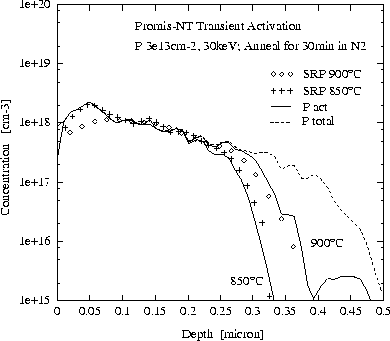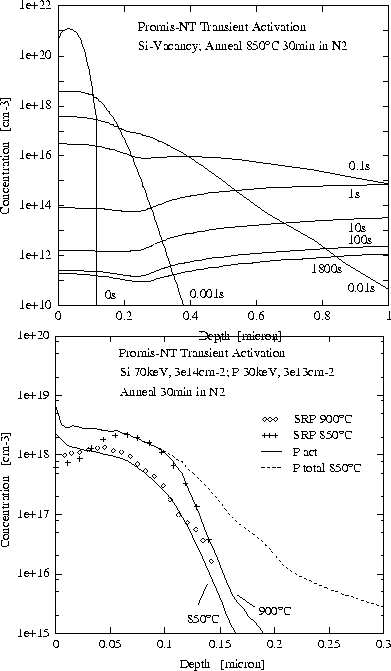Figure 4.3-8 gives the simulation results for a temperature
range of ![]() to
to ![]() including measurements, where the total
phosphorus concentration is compared to the SIMS profile and the
substitutional or active concentration to Spreading Resistance
Profiling (SRP) measurements. Interstitial dopants in the tail region are
available, but they cannot be paired, because the interstitials already
diffused into the bulk. On the other hand, they cannot be activated because
there is no recombination vehicle within the reaction radius. So the vacancy
concentration in combination with the paired dopant stream plays the key
role in activation. Figure 4.3-9 gives the transient profiles of
the vacancy distribution. The vacancy concentration decreases at activation
sites by Frank-Turnbull recombination and in the substrate by bulk
recombination. The activation process is a very short term process and is
nearly finished after a time period of 0.1s. After this activation time
there are not enough vacancies in the vicinity of dopant pairs to continue
activation. The simulation results show, that it is possible to scale the
activation process with the temperature, but at temperatures above
including measurements, where the total
phosphorus concentration is compared to the SIMS profile and the
substitutional or active concentration to Spreading Resistance
Profiling (SRP) measurements. Interstitial dopants in the tail region are
available, but they cannot be paired, because the interstitials already
diffused into the bulk. On the other hand, they cannot be activated because
there is no recombination vehicle within the reaction radius. So the vacancy
concentration in combination with the paired dopant stream plays the key
role in activation. Figure 4.3-9 gives the transient profiles of
the vacancy distribution. The vacancy concentration decreases at activation
sites by Frank-Turnbull recombination and in the substrate by bulk
recombination. The activation process is a very short term process and is
nearly finished after a time period of 0.1s. After this activation time
there are not enough vacancies in the vicinity of dopant pairs to continue
activation. The simulation results show, that it is possible to scale the
activation process with the temperature, but at temperatures above ![]() all of the implanted dopants will be activated during annealing because of
the increased diffusivities of the point defects.
all of the implanted dopants will be activated during annealing because of
the increased diffusivities of the point defects.

Figure 4.3-8: Phosphorus simulation results achieved with the transient
activation model. The tails of the dopant profiles contain large
portions of unactivated dopants after annealing for 30min at ![]() and
and
![]() , respectively.
, respectively.
As a second task we implanted silicon into the silicon target followed by
the dopant implant. This silicon implant affects the initial condition for
the activation model. From the chemical point of view there is no reason to
distinguish between implanted and damage generated silicon interstitials, so
they are summed up to the total available excess concentration of
interstitials. Due to the fact that the crystal channels are now occupied by
previously implanted silicon atoms, the phosphorus atoms are prevented from
channeling [Kas90]. The number of interstitials is orders of magnitude
higher than the number of vacancies at the slope of the dopant profile. This
supersaturation of interstitials enhances the point defect recombination in
that regions with the side-effect of vanishing vacancies needed for
activation. This results in a lower activation profile for the higher
annealing temperature case, which gives a strong reverse temperature
effect. Figure 4.3-10 shows the activated dopant profiles at ![]() and
and ![]() furnace annealing for 30 min in
furnace annealing for 30 min in ![]() ambient. The inaccuracy
of the profiles near the surface is related to surface reactions. As these
surface reactions were not characterized during the experimental procedure,
we neglect them for the model setup.
ambient. The inaccuracy
of the profiles near the surface is related to surface reactions. As these
surface reactions were not characterized during the experimental procedure,
we neglect them for the model setup.

Figure 4.3-9: Transient vacancy
distribution during annealing. After 1s the activation of the dopants is
finished due to the lack of vacancies in the surface region.
Figure 4.3-10: Phosphorus transient activation results for furnace anneals at
![]() and
and ![]() for silicon pre-implanted samples. The pre-implant
reduced the channeling length and causes less activation at higher
temperatures.
for silicon pre-implanted samples. The pre-implant
reduced the channeling length and causes less activation at higher
temperatures.
Our activation model is the first attempt to capture the transient activation process of phosphorus after a sub-amorphizing channeling implant. To quantify both diffusion and activation phenomena at intrinsic doping a non-equilibrium point defect based activation model is required. Our model takes into account all occurring dopant, dopant-pair and point defect species and all effective rate reactions. To our knowledge, there is no other simulation model available to capture such activation effects. To get shallower active profiles the method of pre-implantation of silicon is suitable to avoid dopant channeling and dopant activation in the bulk.